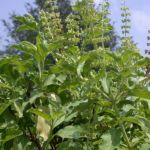
|
| Holy Basil |
While sweet basil, with its savory clove fragrance, is the quintessential Italian culinary herb, basils are available in an amazing range of forms and fragrances—from lemon, lime, anise, spice, cinnamon and thyme to incense and sweet camphor.
There a 64 basil species, all native to the subtropics and tropis, but generally speaking, they are annuals, or evergreen perennials and shrubs, with simple aromatic leaves and spikes of lipped flowers arranged in whorls.
This spice-scented species, which is available in both green-and purple-leafed strains, has a mild spice scent as is widely planted in India around temples and in gardens.
Much-branched, softly hairy perennial with woody-based, often purplish stems, and downy, toothed, often purple-veined and purple flushed, ovate leaves, to 3.5cm (1¼in) long, which have a spicy, pungent aroma. Very small, purple-pink flowers are borne in slender racemes in summer.
With the exception of the perennial basils, basils are generally treated as annuals and propagated by seed. Do not plant seeds directly in the garden until the soil warms. For an early start, plant into seed trays kept in a warm and protected environment. Grow seedlings of smaller varieties in pots or spaced about 1ft (30cm) apart, larger bush types about 1.5ft (45cm) apart. Basils cross very readily between varieties, so seeds saved in a mixed planting will not grow true to type in the following year unless you prevent cross-pollination by bees. You can also take cuttings from side shoots. |
|
Harvest mature leaves and flower spikes for fresh use at any times. To dry the leaves, cut bushes at the base and hang out of direct light, then store in an airtight container in a cool place. |
|
syn. Krishna Tulsi Has pronounced purple coloration and a sweet, clove-like flavor. |
|
Holy basil, and important herb in Ayurvedic meidine, is used for a range of complaints. Scientific research supports its role in the management of diabetes (due to a hypoglycaemic effect) and as a supportive herb during times of stress. It may also improve concentration and memory and, due to an antiallergic effect, may be beneficial in treating hay fever and asthma. |
|
Basil is one of the great culinary herbs; different varieties are used extensively in both European and Asian cooking. If a recipe specifies simply "basil", sweet or common basil (Ocimum basilicum) is the type generally meant. Fresh sweet basil is highly aromatic, with a distinctive scent and flavor reminiscent of aniseed, and tends to be either loved or loathed. Dried basil tastes more of curry, and is a poor substitute for the fresh herb and should be avoided. Using a knife to cut basil can bruise and darken the leaves. For salads and pasta sauces where appearance matters, shred the leaves with your fingers. Young leaves have the best flavor, while old one have a coarser, stronger taste. In cooked dishes, basil quickly loses its aroma and the leaves tend to darken, so add it to give depth of flavor during cooking and then, for fragrance and visual appel, stir in a little more just before serving. Tomato dishes, chicken, egg and rice dishes, spaghetti sauces, fish and vegetables - especially beans, capsicum, and eggplants - all go well with basil. Basil is a good addition to stuffings. The most famous use of basil is in pesto (or pistou in French). Citrus-scented and spice-flavored varieties of basil work well in a range of Asian recipes. |
|
The Complete Illustrated Book of Herbs by Reader's Digest Copyright©2009 The Reader's Digest Association, Inc. Pp.18-20 |